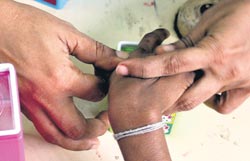
Teaching with a special touchThe holistic approach adopted at Chitra Lane School helps not only intellectually impaired children but also their parents to face a challenging situation The school is nestled comfortably at the end of a narrow street off Chitra Lane. Within its airy halls and brightly decorated rooms, intellectually impaired children come to find comfort and guidance – neither of which is always easy to give or receive. The school is one of a kind, better equipped both in terms of equipment and trained staff than any other facility on the island…yet both the Chitra Lane School for the Special Child and the Children’s Resource Centre are facing a crisis – they need funds and they need them now. When Delysia Gunewardene first began in 1967, there were only two students. A converted garage was to serve as a classroom for the two girls who were both classmates of Mrs. Gunewardene’s daughter. Today the number of students exceeds 250, explains a spokesperson for the school, and it is more of a haven than ever before. Beleaguered parents, struggling to cope with the needs and quirks of their intellectually impaired children come to the centre from as far away as Vavuniya because the centre offers them hope. For many the disappointment is hard to bear when they discover that there are no quick fixes, and that instead the struggle to empower their children will be one that demands a great deal of time, dogged determination and patient sacrifice.
Recognising that more than half the battle lies in supporting the parents themselves, the school undertakes not only parent counselling and training, but also reimbursing transportation costs to and from the school, providing much needed housing and basic facilities, distributing dry rations and medications and even involving itself in income generation projects. Though it may sound excessively generous, this “holistic approach” is only common sense, asserts the spokesperson, saying “we need to actually get them to the school…also you cannot expect children to sit and learn when their bellies are empty.” She adds that more than 80% of the school’s student body is drawn from families living in extreme poverty, with many in addition coming from broken homes. The obstacles posed by such situations must be taken into consideration and addressed before the children are free to actively make the most of the school’s extensive facilities, explains the spokesperson. Once the children are enrolled, they are grouped not on the basis of their age, but according to their level of skill and ability, she reveals, adding that these are all kids with special needs and they have to be taught in a way that they can learn. This means that classes are kept small so that teachers can give greater individual attention to their charges. Junior classes for instance are limited to less than 10 children a teacher. “Teachers do not follow a broadbased curriculum, instead they follow individualised education plans,” says the spokesperson, adding that children are usually assigned to one of three groups: juniors, intermediates and seniors. Typically, students are exposed to a wide range of activities designed to stimulate them, expanding their interests and awareness and enhancing their attention spans as they move along. The ultimate goal, of course, is to liberate them to as great a degree as possible by making them self-sufficient and capable of interacting with society at large. But in the meantime, a little fun is not out of the question. This is just like any other school, says the spokesperson explaining that the institution has its own percussion and western bands, dance teams, guiding and scouting groups as well as an extensive range of activities including swimming and P.E. Very often play is a wonderfully effective teaching tool. And children tend to make good progress, particularly if their condition is detected early. Revealing that they have had babies who were only days old brought in for check-ups, the spokesperson says that the main aim of the Children’s Resource Centre is early detection and intervention. The Resource Centre also serves more children than the school – boasting over 1500 members. Potential patients are brought in and subjected to a thorough assessment from the in-house experts, after which a programme is developed that meets the specific needs that each child has. Each programme may employ several different approaches and therapies simultaneously including hydrotherapy, speech therapy, special education programmes, behaviour modification programmes and more often than not, parent training. “Plus we get our usual school crowd who come in with basic learning disabilities,” says the spokesperson. As awareness spreads, the fear and stigma directed at such children are being tempered by compassion and acceptance. A number of people have stepped forward to sponsor individual children at the centre with a donation of Rs. 1500 made monthly; but both the resource centre and the school are still in dire need of funds to support their programmes and meet administrative costs since their supportive sponsor of 10 years – PLAN International - was forced to withdraw. “PLAN has helped us in every possible way…but since they’ve changed their regional agenda, from next month we will be left without sponsors, and now we’ve got students who need travelling re-imbursements, dry rations…and we also have highly trained staff to pay,” says the spokesperson ruefully. But one thing is for certain, “we simply cannot just close down,” she says, voicing the determination and dedication shared by the entire team at Chitra Lane. |
|| Front
Page | News | Editorial | Columns | Sports | Plus | Financial
Times | International | Mirror | TV
Times | Funday
Times || |
| |
Copyright
2007 Wijeya
Newspapers Ltd.Colombo. Sri Lanka. |
